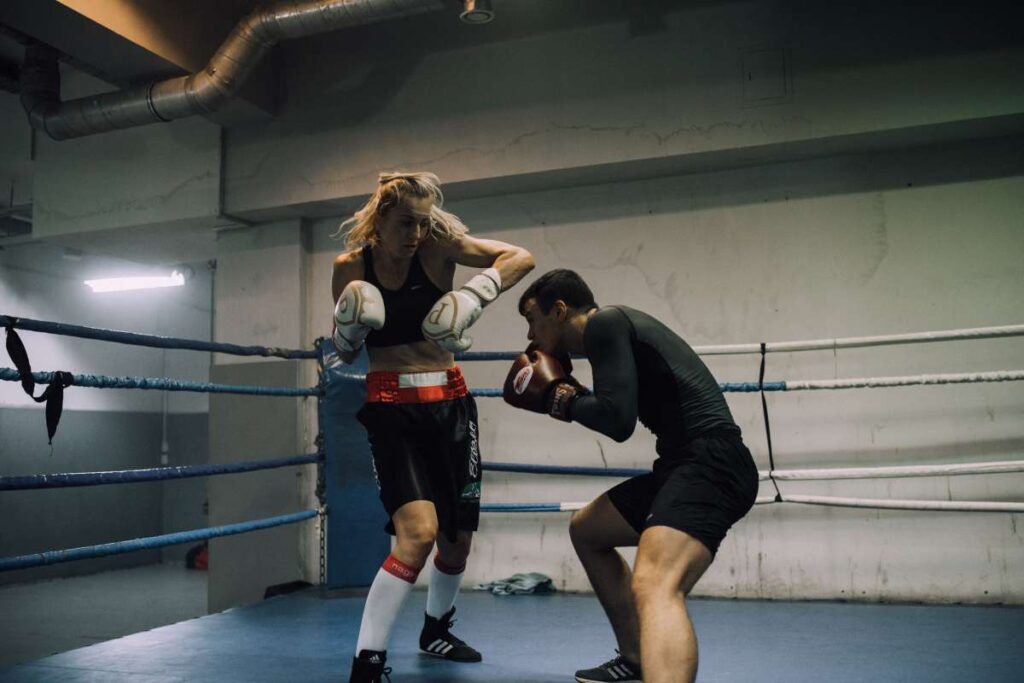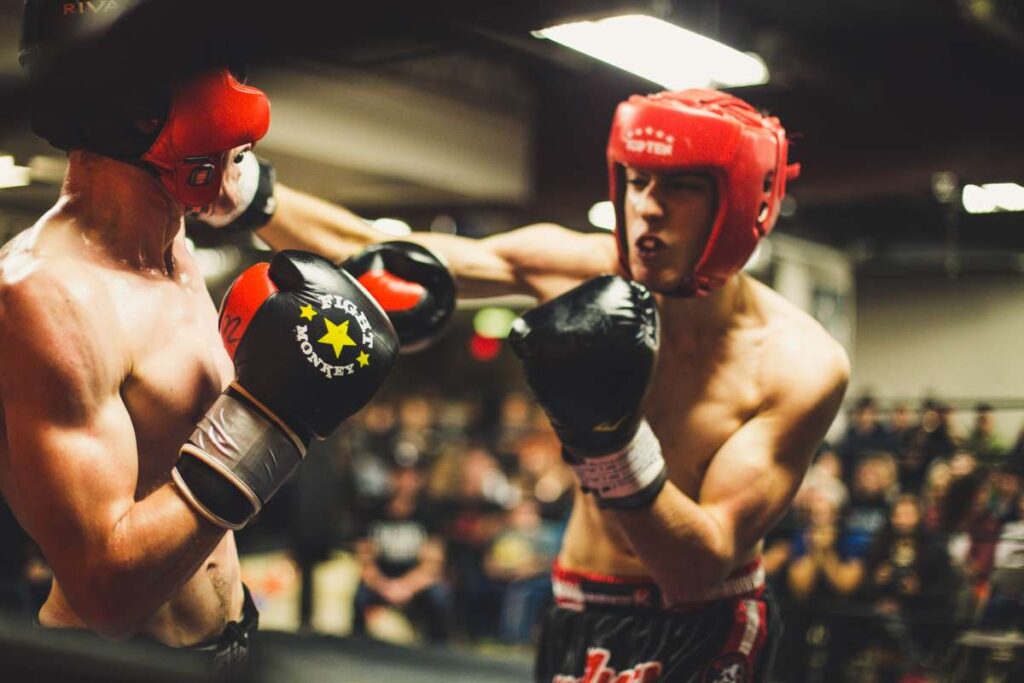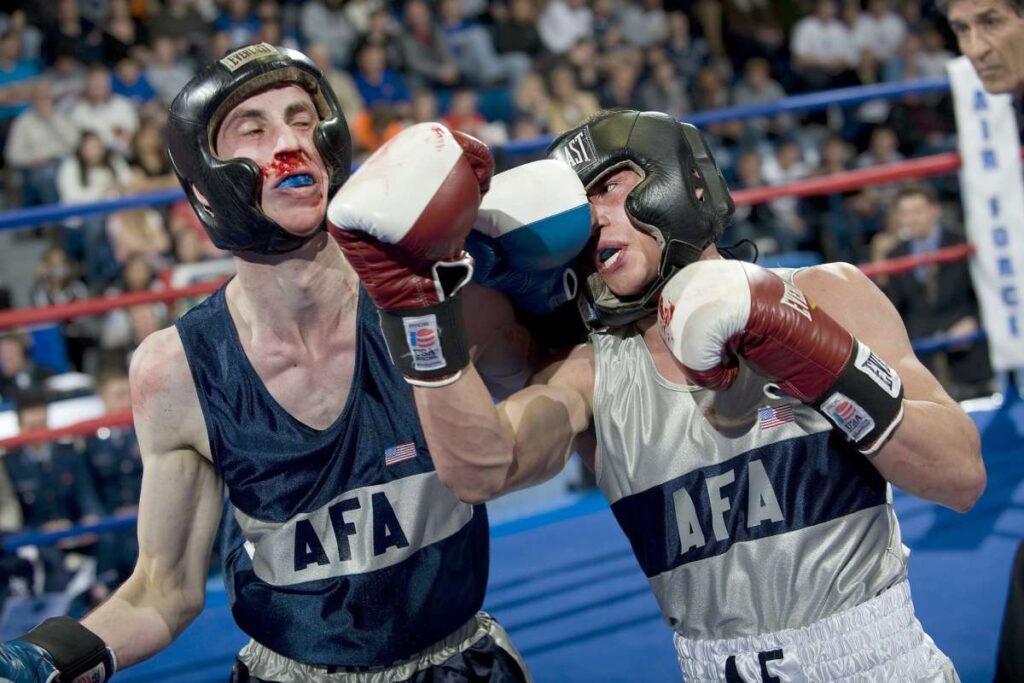Both infamous and misunderstood, the peekaboo look. However, the fact that it is so frequently misinterpreted may work to your advantage. The fundamentals of peekaboo provide boxers with a secure and ready "base of operation," allowing them to move when they want and when they want, effectively dominating their opponent and the fight with little danger.
Any boxer who hopes to have a long and healthy career in the ring should concentrate on creating a strong defensive approach that can effectively shield both his head and body. Unfortunately, the majority of beginners and defensively-minded experts favour what renowned trainer Cus D'Amato called the peekaboo stance.
The peekaboo posture maximises the area of your body covered while in the guard position and can serve as a solid platform for reacting to your opponent's movements with precise counterpunches, despite not being a style that aggressive fighters commonly employ. Having control is a luxury that is not always available. If you want to incorporate the best features of the peekaboo style into your boxing technique, there are a few things you need to be aware of.
If you're a seasoned boxing fan, you might also recall Torres and Patterson if you've read about the peek-a-boo style of boxing in relation to Iron Mike Tyson. When we think of the peek-a-boo boxing style, these are the first three names that come to mind. Understand why? Because they were all taught by the renowned Cus D'Amato. He is credited for developing the boxing technique known as peek-a-boo.
The peek-a-boo technique may appear aggressive while in use, yet it puts emphasis on defence above offence. It is a type of counterpunching that places a focus on airtight defence while a fighter intrudes into an opponent's territory.
There is no way you can avoid a peek a boo strategy. To face such a fighter, the strategy is not to give them away to come out of their guard when you are in the range. Peek a boo is adopted by fighters who usually are in fighters. The best way to face them is to throw bombs at them whenever they try to close down.
You must know that Tyson uses the peek-a-boo style because he's a shorter fighter with shorter arms. So he HAS to wade through many punches when he's out of reach and needs to move his head at all kinds of crazy angles.
It all depends on how long their arms are vs their torso. Tall fighters are generally not built like this, so it is not common to see. Plus, if fighters have long arms, they generally become an out-fighter or a shoulder-roll specialist.
Pressure fighting is a highly effective style that is perhaps the most common in boxing. Well-known boxers in the sport's history who were pressure fighters include Manny "Pacman" Pacquiao, Roberto Duran, and Julio Cesar Chavez.
- Floyd Patterson, The first fighter to use the Peek-A-Boo effectively, became an Olympic gold medalist and 2-time Heavyweight Champion of the world. Also, the first man to ever win back the heavyweight championship.
- Mike Tyson executed the style perfectly and was notorious for his savage punching ability and excellent defence. Probably the best example of the Peek-a-Boo style.
- Kevin Rooney, Mike Tyson's former trainer, is an expert in Peek-A-Boo boxing, having once been a Golden Gloves champion.
FAQs
How The Peek-A-Boo Boxing Style Works
The boxer D'Amato coached before Mike Tyson wasn't the first to successfully employ the peek-a-boo technique at the highest levels of boxing. Floyd Patterson, who won two heavyweight championships as a professional and an Olympic gold medal as an amateur, deserves to get this honour.
With the peek-a-boo technique, you put yourself in a position to land powerful punches while maintaining consistent defence. It provides fighters with complete flexibility of movement and enables them to set the tempo of the fight while reducing their exposure to attacks. Tyson developed a distinctive boxing style that has never been matched because of his training by the late great Cus D'Amato. It was unmatched how quickly he glided about the ring, gliding with the goal of knocking opponents out. Even today, it's one of the most captivating fashion trends to observe.
D'Amato created the peek-a-boo as a defensive strategy that gives boxers control over the tempo of about. It successfully weakens your opponent's defence while enabling you to launch attacks. It's a fantastic fighting style for those that prefer to go close and engage on the inside. It also enables you to throw a potent counterattack.
You must comprehend D'Amato's design principles in order to grasp the peek-a-boo boxing style. Cus thought the best weapon in a boxer's arsenal was the capacity to slip punches. One of the most difficult techniques for boxers to learn is slipping, but D'Amato thought the work to master it was worthwhile. The peek-a-boo strategy is therefore intended for fighters adept at dodging blows and moving their heads, as doing so makes their defence much more difficult to penetrate as they stroll down opponents.
Breaking Down Mike Tyson's Style Of Boxing
In his pomp, "Iron" Mike Tyson, the heavyweight boxing world champion, was unquestionably the most feared figure in the sport. The storied "Baddest Man on the Planet" was a destructive force in the ring, knocking out opponents with concussive force.
Tyson became the sport's youngest world champion when he won his first title at the age of 20 years, four months, and 22 days. From 1987 through 1990, he held the uncontested WBA, WBC, and IBF heavyweight belts simultaneously, making him the first boxer to do so.
The peek-a-boo technique allowed Tyson, a naturally aggressive fighter, to unleash devastating blows on his opponents while limiting his risks. Throughout his reign, Tyson fought in this manner, stalking his opponents, dodging their blows, and scoring vicious counterpunches that rendered several of them unconscious. While Tyson is best known for his devastating knockout power, his accuracy with both his counterpunches and defence (particularly his ability to slip strikes) contributed significantly to his success inside the ring.
Iron Because Mike was an intense pressure fighter by nature, his version of peek-a-boo is distinctive. However, Mike was able to attack and act on impulse while always defending himself by using the defensive tactic of peek-a-boo.
Although the method did have many flaws, Mike's execution of them was so swift and efficient that his rivals were never able to take advantage of them. He used to deliver counterpunches, but he did it with fierce force.
Will Peek-a-boo style work for you?
Everyone can benefit from peek-a-boo. It does, however, favour some combatants over others. For instance, Tyson is the best example of this technique.
Fast Movements
You must effectively decrease or widen the distance when using the peek-a-boo technique. It's an excellent fighting approach for shorter fighters who frequently face bigger, rangier opponents. Even though Tyson was smaller than average for a heavyweight, his explosive power and seed allowed him to compensate, thanks to the peek-a-boo approach.
Although taller boxers, like Floyd Patterson, can also win with style, they typically move more slowly and find it harder to close gaps.
Ambidextrous Approach
This approach will work effectively for boxers who have no trouble converting from Southpaw to Orthodox. Tyson was fluid in his movements and naturally ambidextrous. He used to apply the Dempsey shift, or moving inside, with this motion to move rapidly, narrow the gap, and close the distance.
Before attempting a deep shifting step and a rear straight punch, the Dempsey shift incorporates a linear power shift that combines a straight lead and a training step.
Low Base
If you pay attention to most sports, you'll quickly realise that the shorter athletes are usually the fastest. The lower centre of gravity that shorter people have is a significant contributing component to this. They have more mobility and improved lower body strength as a result.
Tyson's physique gave him a low centre of gravity, allowing him to slip and weave through blows easily.
Raw strength
If you possessed raw power, the peek-a-boo style would work better for you. Landing devastating counters is essential to the entire game strategy. Therefore, it's a big issue if you put in all the effort to go on the inside and outside of your opponent but still can't defeat him.
Therefore, having the raw force to go along with your superb mobility would be ideal. In Tyson's example, his counterpunches frequently led to knockouts. His straights and left hooks are still highly regarded, though.
Explosive Power
Having lethal striking strength would be helpful to pull off the peek-a-boo approach. By getting inside of your opponent, you can deliver hits that end the fight. Being known as a heavy hitter also keeps your adversary from being overly aggressive with their attacks since they are constantly afraid of your countermeasures. Might Tyson have such powerful punches that many of his knockouts were from straight blows?
Advantages Of Peek-A-Boo Boxing Style
The peek-a-boo fashion is widely despised today and receives a lot of criticism. Today's boxing, meanwhile, is different from that of the 1990s, and it's normal to identify weaknesses in your opponent and exploit them in order to defeat them.
- Makes It Easier To Close The Distance: It is simpler to chase down and cut off opponents in the ring when using the squared posture. Additionally, it makes it simpler to land powerful counterattacks as you close the gap.
- Allows For Fast Movements: Shorter combatants are especially affected by this. The design enables quick movements both indoors and outside.
- Great For Offense: A defensive strategy known as peek-a-boo puts you in a great position to launch your offence. It favours combatants who are aggressive and enjoy exchanging powerful blows in close quarters. It enables them to mount a significant offence while lowering their risks.
- It Makes You Harder To Predict: The off-rhythm motions used in the peek-a-boo method might confuse opponents. It requires using unconventional movement and strikes, which makes it more difficult for opponents to predict what you're doing.
Peekaboo Boxing: The Fading Art Of 'Aggressively Safe' Boxing
Due to the fighter's ability to exert control over their opponent, peekaboo boxing is particularly successful. With this fighting method, you can control your opponent and the fight, which means there is no risk associated. You can move whenever you want and wherever you want.
Because peekaboo boxing is a particular kind of boxing that is frequently misinterpreted, this kind of control is a luxury that is difficult to master. The first thing to realise is that learning this method takes time. As a result, even if the process seems too difficult or takes too long, you can't give up.
The fundamentals of peekaboo provide boxers with a secure and ready "base of operation," allowing them to move when they like and control their opponent with little risk. Now, exercising control is not a simple luxury. If you want to incorporate the greatest aspects of the peekaboo style into your boxing technique, there are a few things you need to be aware of.
There is a correct technique to use this style, and in order to succeed, you must totally commit to it. To do this, you must maintain your hands in an upright position to shield your chin and utilise your forearms to shield your torso. To ensure that you are constantly ready to face your opponent, it would be beneficial if you learnt how to hold this position in many scenarios. Trying to imitate a particular move set could be alluring, but doing so will cost you and is not a part of the peekaboo boxing style.
When you use this strategy, your adversary will be forced to expend their energy on ineffective punches and remain cautious even when you're defending. You'll be able to make your opponents wait before striking, leaving them open to quick counterattacks. Always maintain a tight guard when moving so that you can block as you pressure your opponent. Make sure you never offer your opponent a free opportunity.
Role Of Cus D'Amato In Peek-A-Boo Boxing Style
Cus slept in his New York gym due to his commitment to coaching upcoming boxers. Cus embraced optimistic thinking. The mind usually makes things worse than they are, was one of the things he had his students learn. "No matter how he feels, a professional always accomplishes what needs to be done." A professional does not act on impulse by working on the roads at 5 a.m. or heading to the gym to train. His young pupils were to always keep in mind that "Your sensations will lie to you."
Cus D'Amato was born in The Bronx, New York, in 1908 to a working-class Italian family. In the featherweight and lightweight classes, Cus boxed for a limited period of time as an amateur, but an eye injury stopped him from becoming licenced as a professional. Fortunately, as we all know, this was just the start of his illustrious career. Cus slept in his New York gym due to his commitment to coaching upcoming boxers. Cus embraced optimistic thinking. The mind usually makes things worse than they are, which was one of the things he had his students learn.
"No matter how he feels, a professional always accomplishes what needs to be done." A professional does not act on impulse by working on the roads at 5 a.m. or heading to the gym to train. His young pupils were to always keep in mind that "Your sensations will lie to you."
One of the earliest boxing instructors to use psychological training was Cus. Before most people in the West even knew what Zen was, he introduced Zen to boxing. He stated: "Cowards and heroes both experience terror. Heroes respond to it in various ways." He put a lot of effort into training emotional restraint. Example: Tyson ultimately acknowledged that he was afraid before every fight, but from the way his opponents saw him, he was frequently the cause of their fear. D'Amato developed father-son relationships with many of his fighters because of his genuine concern for them. Cus would never disparage Floyd Patterson or allow any of his boxers to speak ill of Floyd, even after Floyd Patterson and Cus decided to separate ways. Floyd would eventually acknowledge that the one period of his life he regretted was the time he spent apart from Cus.
Cus cared so much for his fighters that he declared bankruptcy in 1971, although it was never obvious that any of his fighters were under such financial strain. Jose Torres said his career earnings were around $1 million, "and Cus never collected a penny." Cus also fought against and shielded his fighters from the politics of boxing at the time, frequently turning down contests due to the opponent's affiliations and alleged backroom shenanigans.
The fact that he occasionally advised the late Greatest Muhammad Ali is what received the least attention but is maybe the most intriguing. His Gramercy Gym's location in New York was given the new moniker "Cus D'Amato Way." Even though his life has been the subject of books and films, he still doesn't receive the credit he merits for his contributions to boxing. The man has left a significant and well-respected legacy in the boxing community. Now, onto the look, he spent his entire life honing...
Peekaboo boxing has a certain allure that appears to go lost or at least overlooked in the modern complicated world of boxing. It's simple to overlook the core elements of what made the peekaboo style so successful because there is so much information and content to learn from. Cus stated: "The most difficult skill to master is slipping a punch. But once you do, boxing really begins to be enjoyable!"
The style as Cus himself had designed it has only been adopted by a very small number of fighters. Mike Tyson stands out the most. If we go back any further, Floyd Patterson, a 1952 Olympic Gold Medalist and former World Heavyweight Champion, is another Gramercy alumnus. Jose Torres a former world light heavyweight champion and 1956 Olympic silver medalist. Joey Hadley has won the Golden Gloves award six times. After Cus passed away in 1985, Kevin Rooney continued to train Tyson until 1988.


